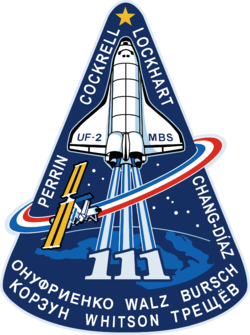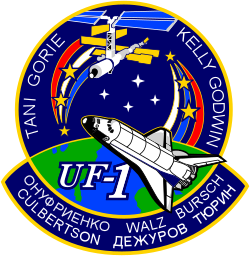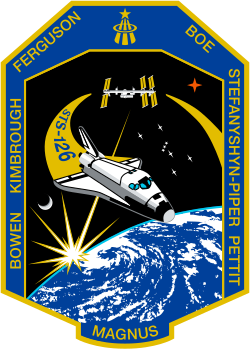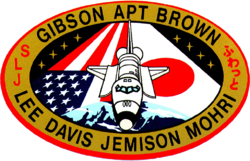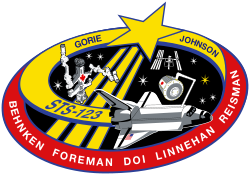Endeavour (Raumfähre)




Das Space Shuttle Endeavour (englisch für Bemühen, Anstrengung) wurde am 25. April 1991 als Ersatz für die Raumfähre Challenger fertiggestellt und hatte seinen Jungfernflug am 7. Mai 1992. Seine interne Bezeichnung lautet OV-105. Der letzte Start fand am 16. Mai 2011 um 14:56 Uhr MESZ statt, die letzte Landung am 1. Juni 2011 um 8:35 Uhr MESZ in Florida. Die erste Besatzung des CrewDragon war bereits mit dem Shuttle Endeavour im All gewesen und benannte ihr Raumschiff entsprechend auch Endeavour.
Geschichte
Der Name für die Raumfähre wurde durch einen Schülerwettbewerb gefunden, an dem insgesamt 71.652 Schüler teilnahmen. Im Mai 1989 verkündete US-Präsident George H. W. Bush den Namen Endeavour nach dem gleichnamigen ersten Schiff von James Cook (daher auch die britische Schreibweise anstelle der im amerikanischen Englisch richtigen Schreibweise Endeavor).
Die Endeavour wurde von Rockwell International gebaut und kostete insgesamt 2,2 Milliarden US-Dollar. Sie absolvierte 25 erfolgreiche Flüge. Als letzte fertiggestellte Raumfähre des Programms absolvierte sie zwar unter den erhalten gebliebenen Orbitern die wenigsten Flüge und auch weniger als die verunglückte Columbia, war aber dennoch an mehr Außenbordeinsätzen beteiligt als alle anderen Shuttles.
Zuletzt wurde das Shuttle zwischen Dezember 2003 und Oktober 2005 grundüberholt (Orbiter Major Modification Period) und erhielt dabei wichtige technische und sicherheitsrelevante Verbesserungen. Neben dem sogenannten Gläsernen Cockpit, einer mit mehreren frei belegbaren Monitoren ausgerüsteten Instrumententafel, erhielt die Endeavour dabei ein verbessertes Navigationssystem zur Positionsbestimmung und die aus den Empfehlungen des „Columbia Accident Investigation Boards“ resultierende Robotarm-Verlängerung Orbiter Boom Sensor System (OBSS).
Nach ihrer letzten Mission im Mai/Juni 2011 wurde die Raumfähre mit Ende des amerikanischen Shuttle-Programms als Museumsstück dem California Science Center in Los Angeles zugewiesen und ist dort seit Oktober 2012 ausgestellt.[1]
Wichtige Missionen:
- Hubble Space Telescope Servicing Mission 1, STS-61 (Dezember 1993) – Korrektur der fehlerhaften Optik
- Shuttle Radar Topography Mission, STS-99 (Februar 2000)
Missionen
| Nr. | Start | Bezeichnung | Emblem | Besatzung |
|---|---|---|---|---|
| 1 | 7. Mai 1992 | STS-49 | Daniel Brandenstein, Kevin Chilton, Pierre Thuot, Kathryn Thornton, Richard Hieb, Thomas Akers, Bruce Melnick | |
| 2 | 12. September 1992 | STS-47 | Robert Gibson, Curtis Brown, Mark Lee, Jan Davis, Jerome Apt, Mae Jemison, Mamoru Mōri | |
| 3 | 13. Januar 1993 | STS-54 | John Casper, Donald McMonagle, Mario Runco, Gregory Harbaugh, Susan Helms | |
| 4 | 21. Juni 1993 | STS-57 | Ronald Grabe, Brian Duffy, David Low, Nancy Currie, Peter Wisoff, Janice Voss | |
| 5 | 2. Dezember 1993 | STS-61 | Richard Covey, Kenneth Bowersox, Story Musgrave, Kathryn Thornton, Claude Nicollier, Jeffrey Hoffman, Thomas Akers | |
| 6 | 9. April 1994 | STS-59 | Sidney Gutierrez, Kevin Chilton, Linda Godwin, Jerome Apt, Michael Clifford, Thomas Jones | |
| 7 | 30. September 1994 | STS-68 | Michael Baker, Terrence Wilcutt, Thomas Jones, Steven Smith, Daniel Bursch, Peter Wisoff | |
| 8 | 2. März 1995 | STS-67 | Stephen Oswald, William Gregory, Tamara Jernigan, John Grunsfeld, Wendy Lawrence, Ronald Parise, Samuel Durrance | |
| 9 | 7. September 1995 | STS-69 | David Walker, Kenneth Cockrell, James Voss, James Newman, Michael Gernhardt | |
| 10 | 11. Januar 1996 | STS-72 | Brian Duffy, Brent Jett, Leroy Chiao, Daniel Barry, Winston Scott, Kōichi Wakata | |
| 11 | 19. Mai 1996 | STS-77 | John Casper, Curtis Brown, Daniel Bursch, Marc Garneau, Mario Runco, Andrew Thomas | |
| 12 | 23. Januar 1998 | STS-89 | Terrence Wilcutt, Joe Edwards, Bonnie Dunbar, Michael Anderson, James Reilly, Salischan Scharipow | |
| 13 | 4. Dezember 1998 | STS-88 | Robert Cabana, Frederick Sturckow, Nancy Currie, Sergei Krikaljow, James Newman, Jerry Ross | |
| 14 | 11. Februar 2000 | STS-99 | Kevin Kregel, Dominic Gorie, Janet Kavandi, Janice Voss, Mamoru Mōri, Gerhard Thiele | |
| 15 | 1. Dezember 2000 | STS-97 | Brent Jett, Michael Bloomfield, Marc Garneau, Carlos Noriega, Joseph Tanner | |
| 16 | 19. April 2001 | STS-100 | Kent Rominger, Jeffrey Ashby, Umberto Guidoni, Chris Hadfield, Juri Lontschakow, Scott Parazynski, John Phillips | |
| 17 | 5. Dezember 2001 | STS-108 | Dominic Gorie, Mark Kelly, Linda Godwin, Daniel Tani | |
| 18 | 5. Juni 2002 | STS-111 | Kenneth Cockrell, Paul Lockhart, Franklin Chang-Diaz, Philippe Perrin | |
| 19 | 24. November 2002 | STS-113 | James Wetherbee, Paul Lockhart, Michael López-Alegría, John Herrington | |
| 20 | 8. August 2007 | STS-118 | Scott Kelly, Charles Hobaugh, Barbara Morgan, Richard Mastracchio, Tracy Caldwell, Dafydd Williams, Alvin Drew | |
| 21 | 11. März 2008 | STS-123 | Dominic Gorie, Gregory H. Johnson, Robert Behnken, Michael Foreman, Richard Linnehan, Takao Doi | |
| 22 | 15. November 2008 | STS-126 | Christopher Ferguson, Eric Boe, Stephen Bowen, Heidemarie Stefanyshyn-Piper, Donald Pettit, Shane Kimbrough | |
| 23 | 15. Juli 2009 | STS-127 | Mark Polansky, Douglas Hurley, Christopher Cassidy, Thomas Marshburn, David Wolf, Julie Payette | |
| 24 | 8. Februar 2010 | STS-130 | George Zamka, Terry Virts, Robert Behnken, Kathryn Hire, Nicholas Patrick, Stephen Robinson | |
| 25 | 16. Mai 2011 | STS-134 | Mark Kelly, Gregory H. Johnson, Michael Fincke, Greg Chamitoff, Andrew Feustel, Roberto Vittori |
Trivia
Das Shuttle hatte eine kleine Rolle in dem Film The Core.
In dem Film Moonfall wird die ausgemusterte Endeavour 2021 für eine Mondmission reaktiviert.
Der kleine Maulwurf, eine Zeichentrickfigur, wurde von Andrew Jay Feustel auf die letzte Mission in Form eines Plüschtiers mitgeführt und dem Erfinder, Zdeněk Miler, nach der Rückkehr übergeben.[2]
Zu Ehren des Shuttles Endeavour benannten die beiden Astronauten der Mission SpX-DM2 ihre Dragon-Kapsel in der Erdumlaufbahn in Endeavour um. Beide hatten ihre ersten Raumflüge mit diesem Shuttle unternommen[3].
Die Endeavour existiert als Modell im Flugsimulator X-Plane und kann dort zur Simulation eines Wiedereintritts genutzt werden.
Siehe auch
Weblinks
- Raumfahrer.net: Endeavour (OV-105)
- NASA: Beschreibung und Flüge (englisch)
- NASASpaceflight.com: Chronik der Raumfähre Endeavour, Teil 1 und Teil 2 (englisch)
- APOD: Das Cockpit der Raumfähre Endeavour (18. April 2012)
Einzelnachweise
- ↑ Samuel Oschin Pavilion – California ScienCenter. Abgerufen am 30. Oktober 2012.
- ↑ Endeavour-Astronaut beschenkt Vater vom "Kleinen Maulwurf". (digitalfernsehen.de [abgerufen am 6. Mai 2018]).
- ↑ Crew Dragon’s astronauts give their SpaceX spaceship a storied name: Endeavour. 31. Mai 2020, abgerufen am 31. Mai 2020 (amerikanisches Englisch).
Auf dieser Seite verwendete Medien
STS111-S-001 --- The STS-111 patch symbolizes the hardware, people, and partner nations that contribute to the flight. The Space Shuttle rises on the plume of the Astronaut Office symbol, carrying the Canadian Mobile Base System (MBS) for installation while docked to the International Space Station (ISS). The mission is named UF-2 for ISS Utilization Flight number two. The ISS orbit completes the Astronaut Office symbol and is colored red, white, and blue to represent the flags of the United States, Russia, France, and Costa Rica. The Earth background shows Italy, which contributes the Multi Purpose Logistics Module (MPLM) used on this flight to re-supply ISS. The ten stars in the sky represent the ten astronauts and cosmonauts on orbit during the flight, and the star at the top of the patch represents the Johnson Space Center, in the state of Texas, from which the flight is managed. The names of the STS-111 crew border the upper part of the patch, and the Expedition Five (going up) and Expedition Four (coming down) crews’ names form the bottom of the patch. The NASA insignia design for Shuttle flights is reserved for use by the astronauts and for other official use as the NASA Administrator may authorize. Public availability has been approved only in the forms of illustrations by the various news media. When and if there is any change in this policy, which is not anticipated, the change will be publicly announced.
* This is the crew patch for the STS-113 mission, which will be the eleventh American (11A) assembly flight to the International Space Station (ISS). The primary mission will be to take the Expedition Six crew to the ISS and return the Expedition Five crew to Earth. STS-113 will be the first flight in the assembly sequence to install a major component in addition to performing a crew exchange. The Port 1 Integrated Truss Assembly (P1) will be the first truss segment on the left side of the ISS. P1 will provide an additional three External Thermal Control System radiators, adding to the three radiators on the Starboard 1 (S1) Integrated Truss Assembly. The installation and outfitting of P1 will require three extravehicular activities (space walks) as well as coordination between the Shuttle Robotic Manipulator System and the Space Station Robotic Manipulator System. The patch depicts the Space Shuttle Endeavour docked to the ISS during the installation of the P1 truss with the gold astronaut symbol in the background.
- The seven stars at the top left center of the patch are the seven brightest stars in the constellation Orion. They represent the combined seven crew members (four Shuttle and three Expedition Six). The three stars to the right of the astronaut symbol represent the returning Expedition Five crew members. The Shuttle crew names are on the solar arrays of the P6 truss. The ISS Expedition crew names are in a chevron that also features the American and Russian flags. The Expedition 6 crew names are on top of the Expedition 5 crew names, since Expedition 6 goes up while Expedition 5 goes down. The Roman Numeral CXIII represents the mission number 113.
STS-49 Patch
- STS-49 Endeavour, Orbiter Vehicle (OV) 105, crew insignia (logo), the official insignia of the NASA STS-49 mission, captures space flight's spirit of exploration which has its origins in the early seagoing vessels that explored the uncharted reaches of Earth and its oceans. The ship depicted on the patch is HMS Endeavour, the sailing vessel which Captain James Cook commanded on his first scientific expedition to the South Pacific. Just as Captain Cook engaged in unprecedented feats of exploration during his voyage, on Endeavour's maiden flight, its crew will expand the horizons of space operations with an unprecedented rendezvous and series of three space walks. During three consecutive days of extravehicular activity (EVA), the crew will conduct one space walk to retrieve, repair and deploy the INTELSAT IV-F3 communications satellite, and two additional EVAs to evaluate the potential Space Station Freedom (SSF) assembly concepts. The flags flying on Endeavour's masts wear the colors of the two schools that won the nationwide contest when Endeavour was chosen as the name of NASA's newest Space Shuttle: Senatobia (Mississippi) Middle School and Tallulah Falls (Georgia) School The names of the STS-49 flight crewmembers are located around the edge of the patch. They are Commander Daniel C. Brandenstein, Pilot Kevin P. Chilton, Mission Specialist (MS) Pierre J. Thuot, MS Kathryn C. Thornton, MS Richard J. Hieb, MS Thomas D. Akers, and MS Bruce E. Melnick. Each crewmember contributed to the design of the insignia.
Designed by the crew members, this patch commemorates the first assembly flight to carry United States-built hardware for constructing the International Space Station (ISS). This flight's primary task is to assemble the cornerstone of the Space Station: the Node with the Functional Cargo Block (fgb).
The rising sun symbolizes the dawning of a new era of international cooperation in space and the beginning of a new program: the International Space Station. The Earth scene outlines the countries of the Station Partners: the United States, Russia, those of the European Space Agency (ESA), Japan, and Canada. Along with the Pressurized Mating Adapters (PMA) and the Functional Cargo Block, the Node is shown in the final mated configuration while berthed to the Space Shuttle during the STS-88/2A mission.
* In the STS-89 crew insignia, the link between the United States and Russia is symbolically represented by the Space Shuttle Endeavour and Russia's Mir Space Station orbiting above the Bering Strait between Siberia and Alaska. The success of the joint United States-Russian missions is depicted by the Space Shuttle and Mir colored by the rising sun in the background.
- A shadowed representation of the International Space Station (ISS) rising with the sun represents the future program for which the Shuttle-Mir missions are prototypes. The inside rim of the insignia describes the outline of the number eight representing STS-89 as the eighth Shuttle/Mir docking mission.
- The nine stars represent the nine joint missions to be flown of the program and when combined with the number eight in the rim, reflect the mission number. The nine stars also symbolize the children of the crew members who will be the future beneficiaries of the joint development work of the space programs of the two countries.
- Along the rim are the crew members' names with David A. Wolf's name on the left and Andrew S. W. Thomas' name on the right, the returning and upgoing cosmonaut guest researcher crew members. In between and at the bottom is the name of Salizan S. Sharipov, payload specialist representing Russian Space Agency (RSA), in Cyrillic alphabet.
- The other crew members are Terrence W. Wilcutt, commander; Joe F. Edwards, Jr., pilot; and mission specialists Michael P. Anderson, Bonnie J. Dunbar, and James F. Reilly. The red, white and blue of the rim reflect the colors of the American and Russian flags which are also represented in the rim on either side of the joined spacecraft.
The STS-118 patch represents Space Shuttle Endeavour on its mission to help complete the assembly of the International Space Station (ISS), and symbolizes the pursuit of knowledge through space exploration. The flight will accomplish its ISS 13A.1 assembly tasks through a series of spacewalks, robotic operations, logistics transfers, and the exchange of one of the three long-duration expedition crew members. On the patch, the top of the gold astronaut symbol overlays the starboard S-5 truss segment, highlighting its installation during the mission. The flame of knowledge represents the importance of education, and honors teachers and students everywhere. The seven white stars and the red maple leaf signify the American and Canadian crew members, respectively, flying aboard Endeavour.
This is the mission patch of STS-108. Space Shuttle Endeavour is seen approaching the International Space Station. Two astronaut symbols represent the crew commanders of both ISS expeditions. The ascending one represents cosmonaut Yury Onufriyenko of Russia. (The ascending astronaut symbol shows a flag of Russia.) The descending astronaut symbol represents Frank Culbertson of the USA. This represents crew rotation, as three stars are depicted on the symbols. The space shuttle crew members are depicted along the border while the ISS crews are depicted along the chevron on the border of the patch.
- This is the insignia for the STS-108 mission, which marks a major milestone in the assembly of the International Space Station (ISS) as the first designated Utilization Flight, UF-1. The crew of Endeavour will bring the Expedition Four crew to ISS and return the Expedition Three crew to Earth. Endeavour will also launch with a Multi-Purpose Logistics Module (MPLM) that will be berthed to ISS and unloaded. The MPLM will be returned to Endeavour for the trip home and used again on a later flight. The crew patch depicts Endeavour and the ISS in the configuration at the time of arrival and docking. The Station is shown viewed along the direction of flight as will be seen by the Shuttle crew during their final approach and docking along the X-axis. The three ribbons and stars on the left side of the patch signify the returning Expedition Three crew. The red, white and blue order of the ribbons represents the American commander for that mission. The three ribbons and stars on the right depict the arriving Expedition Four crew. The white, blue, red order of the Expedition Four ribbon matches the color of the Russian flag and signifies that the commander of Expedition Four is a Russian cosmonaut. Each white star in the center of the patch represents the four Endeavour crew members. The names of the four astronauts who will crew Endeavour are shown along the top border of the patch. The three astronauts and three cosmonauts of the two expedition crews are shown on the chevron at the bottom of the patch.
STS099-(S)-001 (JUNE 1999) STS-99 INSIGNIA -- The crew members designed the flight insignia for the Shuttle Radar Topography Mission (SRTM), the most ambitious Earth mapping mission to date. Two radar antennas, one located in the Shuttle bay and the other located on the end of a 60-meter deployable mast, will be used during the mission to map Earth's features. The goal is to provide a 3-dimensional topographic map of the world's surface up to the Arctic and Antarctic Circles. The clear portion of Earth illustrates the radar beams penetrating its cloudy atmosphere and the unique understanding of the home planet that is provided by space travel. The grid on Earth reflects the mapping character of the SRTM mission. The patch depicts the Space Shuttle Endeavour orbiting Earth in a star spangled universe. The rainbow along Earth's horizon resembles an orbital sunrise. The crew deems the bright colors of the rainbow as symbolic of the bright future ahead because of human beings' venturing into space.
STS-54 Mission Insignia
The STS-126 patch represents Space Shuttle Endeavour on its mission to help complete the assembly of the International Space Station (ISS). The inner patch outline depicts the Multi-Purpose Logistics Module (MPLM) Leonardo. This reusable logistics module will carry the equipment necessary to sustain a crew of six on board the ISS and will include additional crew quarters, exercise equipment, galley, and life support equipment. In addition, a single expedition crew member will launch on STS-126 to remain on board ISS, replacing an expedition crew member who will return home with the shuttle crew. Near the center of the patch, the constellation Orion reflects the goals of the human spaceflight program, returning us to the Moon and on to Mars, the red planet, which are also shown. At the top of the patch is the gold symbol of the astronaut office. The sunburst, just clearing the horizon of the magnificent Earth, powers all these efforts through the solar arrays of the ISS current configuration orbiting high above.
STS-57 Endeavour, Orbiter Vehicle (OV) 105, crew insignia (logo), the Official insignia of the NASA STS-57 mission, depicts the Space Shuttle Endeavour maneuvering to retrieve the European Retrievable Carrier (EURECA) microgravity experiment satellite. Spacehab -- the first commercial space laboratory -- is depicted in the cargo bay (payload bay (PLB)), and its characteristic shape is represented by the inner red border of the patch. The three gold plumes surrounded the five stars trailing EURECA are suggestive of the United States (U.S.) astronaut logo. The five gold stars together with the shape of the orbiter's mechanical arm form the mission's numerical designation. The six stars on the American flag represent the U.S. astronauts who comprise the crew. With detailed input from the crewmembers, the final artwork was accomplished by artist Tim Hall. The names of the STS-57 flight crewmembers are located along the border of the patch. They are Commander Ronald J. Grabe, Pilot Brian J.
STS-59 crew insignia
- The STS-59 insignia is dominated by Earth, reflecting the focus of the first Space Radar Laboratory (SRL-1) mission upon our planet's surface and atmosphere. The golden symbol of the astronaut corps emblem sweeps over Earth's surface from the Space Shuttle Endeavour, representing the operation of the SIR-C/Synthetic Aperture Radar (X-SAR) and the Measurement of Air Pollution from Space (MAPS) sensors. The astronaut emblem also signals the importance of the human element in space exploration and in the study of our planet. The star field visible below Earth represents the many talents and skill of the international SRL-1 team.
Logo of Nasa's STS-100 mission.
- The STS-100/6A emblem reflects the complex interaction of robotics and extravehicular activity (EVA) on this mission. During the mission spacewalks will be conducted to deploy the International Space Station Remote Manipulator System (SSRMS). The EVA helmet frames the patch, with the Canadian-built SSRMS shown below the visor. Reflected in the visor is the Space Shuttle Endeavour, with the International Space Station rising above the horizon at orbital sunrise. Endeavour's payload bay houses a Spacelab pallet, itself holding the SSRMS and the Space Station Ultra High Frequency Antenna, and the Italian-built Multi-Purpose Logistics Module "Raffaello." American, Russian, Canadian, and Italian astronauts compose the crew, and their flags are stylized in the lower portion of the emblem. Ten stars adorn the sky, representing the children of the STS-100 crew and the future of space exploration.
Emblem of Nasa's STS-69 mission.
- Designed by the mission crew members, the patch for STS-69 symbolizes the multifaceted nature of the flight's mission. The primary payload, the Wake Shield Facility (WSF), is represented in the center by the astronaut emblem against a flat disk. The astronaut emblem also signifies the importance of human beings in space exploration, reflected by the planned space walk to practice for International Space Station (ISS) activities and to evaluate space suit design modifications. The two stylized Space Shuttles highlight the ascent and entry phases of the mission. Along with the two spiral plumes, the stylized Space Shuttles symbolize a NASA first, the deployment and recovery on the same mission of two spacecraft (both the Wake Shield Facility and the Spartan). The constellations Canis Major and Canis Minor represent the astronomy objectives of the Spartan and International Extreme Ultraviolet Hitchhiker (IEH) payload. The two constellations also symbolize the talents and dedication of the support personnel who make Space Shuttle missions possible.
Aufstieg der Raumfähre Atlantis am 2. Dezember 1988 mit der Mission STS-27.
Space Shuttle mission STS-127 is the 32nd construction flight of the International Space Station (ISS) and the final of a series of three flights dedicated to the assembly of the Japanese "Kibo" laboratory complex. In addition to delivering, installing, and servicing an external scientific platform that will be attached to the end of the Japanese module, STS-127 will bring up a new ISS crew member and return another one to Earth, replace vital components of the ISS electrical production system, and transfer various pieces of hardware to ISS. Five spacewalks and the operation of four different robotic arms will be required to accomplish these tasks over 10 days. A crew spokesperson had the following words for the patch. "Bathed in sunlight, the blue Earth is represented without boundaries to remind us that we all share this world. In the center, the golden flight path of the space shuttle turns into the three distinctive rays of the astronaut symbol culminating in the star-like emblem characteristic of the Japanese Space Agency, yet soaring further into space as it paves the way for future voyages and discoveries for all humankind."
Space Shuttle Endeavour seems to leap from the among the palmettos on its launch into the clear blue Florida sky. Launch of Endeavour on mission STS-99 occurred at 12:43:40 p.m. EST. Known as the Shuttle Radar Topography Mission (SRTM), STS-99 will chart a new course to produce unrivaled 3-D images of the Earth's surface. The result of the SRTM could be close to 1 trillion measurements of the Earth's topography. The mission is expected to last 11 days, with Endeavour landing at KSC Tuesday, Feb. 22, at 4:36 p.m. EST. This is the 97th Shuttle flight and 14th for Shuttle Endeavour.
STS-67 Mission Insignia
STS-68 Mission Insignia
Emblem of Nasa's STS-61 mission.
Autor/Urheber: SvenPaulus (Diskussion), Lizenz: Copyrighted free use
Das Space Shuttle Endeavour im Samuel Oschin Pavilion des California Science Center in Los Angeles (2017)
Der offizielle Aufnäher für STS-130. Die Form des Stickers symbolisiert Cupola, die mit Fenstern versehene robotische Aussichtsstation von wo Astronauten die Gelegenheit haben, nicht nur eine Vielzahl von ISS Tätigkeiten zu überwachen, sondern auch unseren Heimatplaneten zu studieren. Das Abbild der Erde im Sticker ist die erste Fotografie der Erde vom Mond aus, aufgenommen am 23. August 1966 von Lunar Orbiter 1. So ist der Mond als vergangenes und zukünftiges Ziel für Forscher vom Planeten Erde im STS-130 Sticker symbolisiert. Das sich der ISS nähernde Space Shuttle Endeavour steht für die Rolle des Space Shuttles als Hauptaufbaufahrzeug für die ISS.
Emblem of Nasa's STS-77 mission.
This is the crew insignia for STS-97, which will deliver, assemble, and activate the U.S. electrical power system on board the International Space Station (ISS). The electrical power system, which is built into a 47-foot integrated truss structure known as P6, consists of solar arrays, radiators, batteries, and electronics. P6 will be attached to the Station using the Shuttle's robotic arm in coordination with spacewalking crewmembers that will make the final connections. The spacewalkers will then prepare P6 for the subsequent deployments of the large solar arrays and radiator, which are critical steps in the activation of the electrical power system. The 120-foot solar arrays will provide the power necessary for the first ISS crews to live and work in the U.S. segment.
The crew patch depicts the Space Shuttle docked to ISS in low Earth orbit after the activation of the P6 electrical power system. Gold and silver are used to highlight the portion of ISS that will be installed by the STS-97 crew. The Sun, central to the design, is the source of energy for ISS.
The mission emblem of STS-47 depicts the Space Shuttle Orbiter with the Spacelab module in the cargo bay against a backdrop of the flags of the United States and Japan, symbolizing the side-by-side cooperation of the two nations in this mission. The land masses of Japan and Alaska are represented on the emblem emphasizing the multi-national aspect of the flight as well as the high inclination orbit of 57 degrees. The initials `SLJ' on the left border of the emblem stand for Spacelab Japan, but the name generally used for the mission is `Spacelab-J.' The Japanese characters on the right border form the word `Fuwatto' which is the Japanese word for weightlessness.
STS-123 continues assembly of the International Space Station (ISS). The primary mission objectives include rotating an expedition crew member and installing both the first component of the Japanese Experimental Module (the Experimental Logistics Module - Pressurized Section (ELM-PS)) and the Canadian Special Purpose Dexterous Manipulator (SPDM). In addition, STS-123 will deliver various spare ISS components and leave behind the sensor boom used for inspecting the shuttle's thermal protection system. A follow-on mission to ISS will utilize and then return home with this sensor boom. A total of five spacewalks are planned to accomplish these tasks. The mission will also require the use of both the shuttle and ISS robotic arms. STS-123 will utilize the Station-Shuttle Power Transfer System to extend the docked portion of the mission to eleven days, with a total planned duration of 15 days. The crew patch depicts the space shuttle in orbit with the crew names trailing behind. STS-123's major additions to ISS (the ELM-PS installation with the shuttle robotic arm and the fully constructed SPDM) are both illustrated. The ISS is shown in the configuration that the STS-123 crew will encounter when they arrive.
Autor/Urheber: Steve Jurvetson, Lizenz: CC BY 2.0
At Kennedy Space Center. Getting ready for Launch.... The astronauts had just bid farewell to their families.
STS-72 Mission Insignia
Das Design des STS-134 Mannschaftsemblems unterstreicht die Forschung auf der Internationalen Raumstation (ISS), die sich der grundlegenden Physik des Universums widmet. Die Crew des Space Shuttles Endeavour wird bei dieser Mission das Alpha-Magnet-Spektrometer-Experiment installieren, ein Detektor von kosmischen Teilchen,
Flag of the Space Shuttle Endeavour, generally flown at the Kennedy Space Center while the orbiter was on the launch pad or on a mission.

